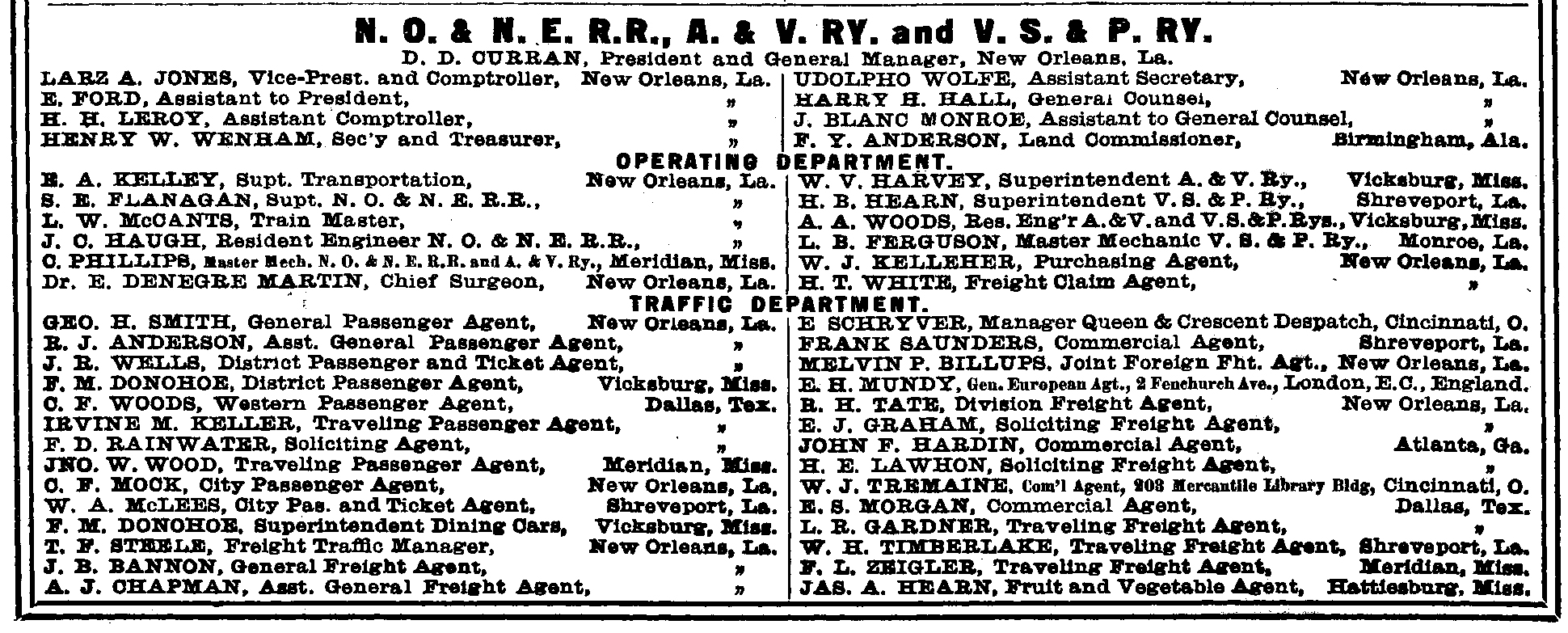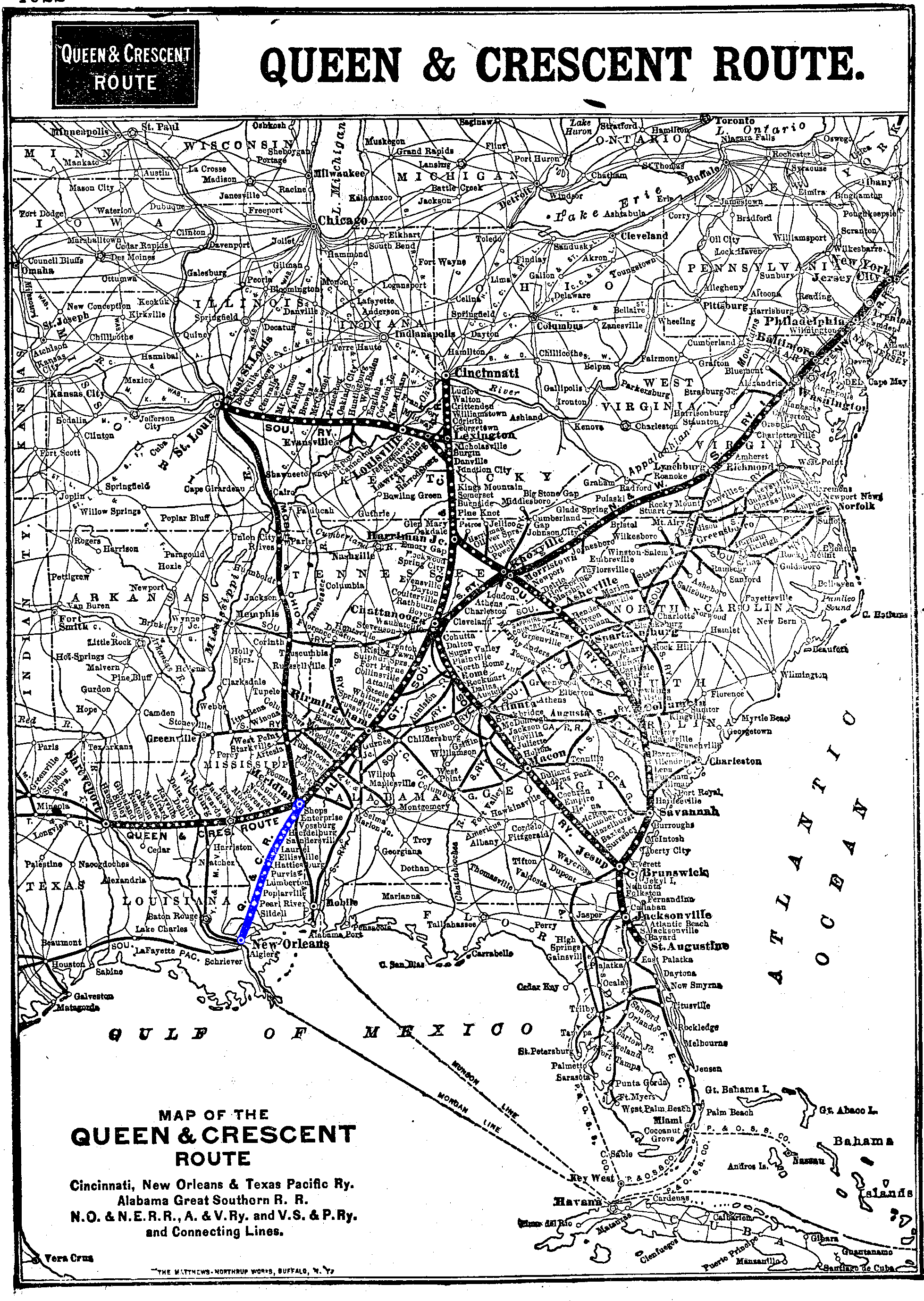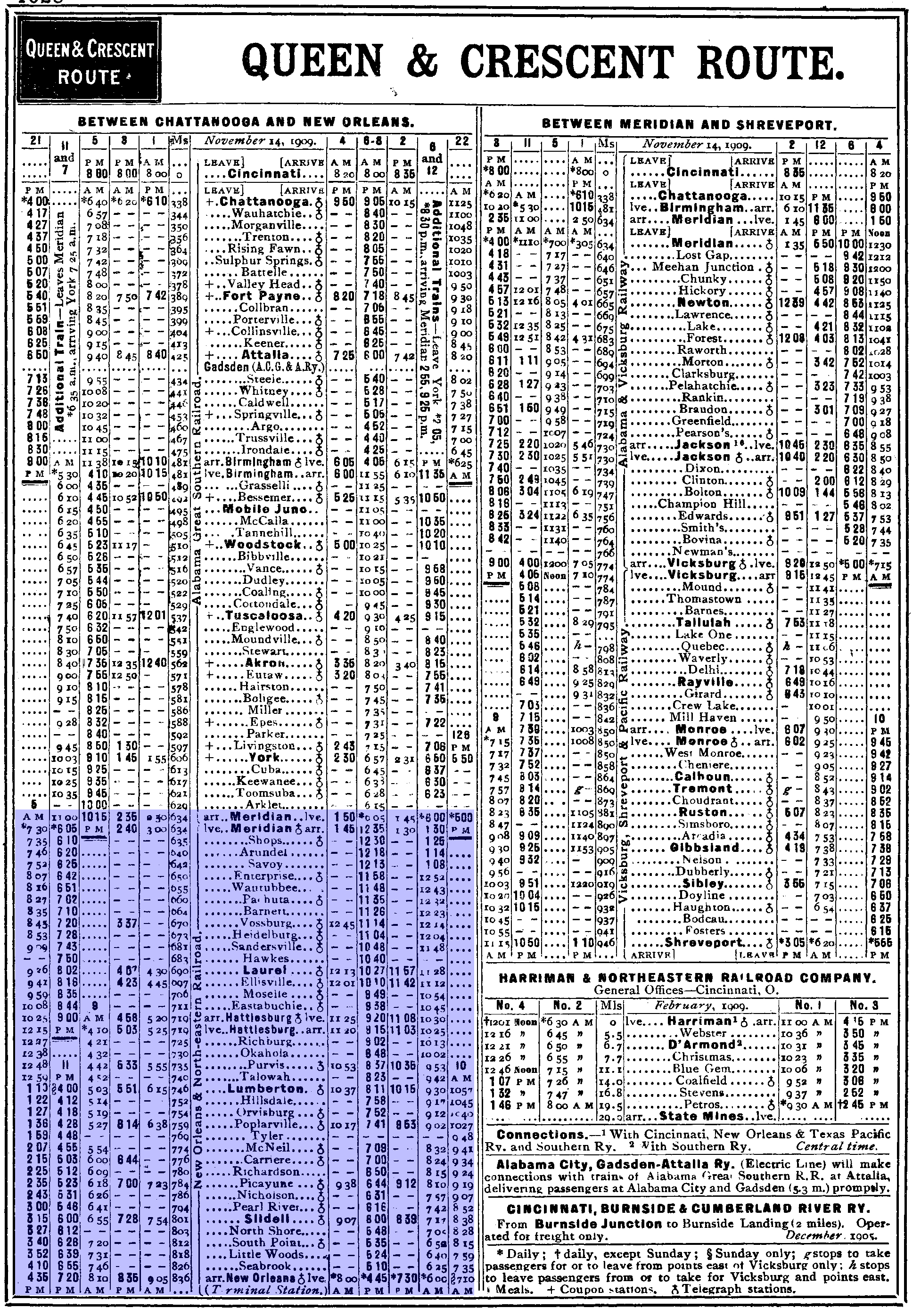New Orleans and Northeastern Railroad: Map, History, Timetables
Published: February 17, 2025
By: Adam Burns
The New Orleans & Northeastern Railroad (NO&NE) played a significant role in the development and economic growth of the southeastern United States. Its history is marked by its strategic importance in connecting major cities and facilitating the movement of goods and passengers.
Formally, the NO&NE disappeared in 1969 when it was merged into Southern Railway subsidiary Alabama Great Southern. However, it remains a vital component of the modern Norfolk Southern's main line to New Orleans.
System Map (1910)
Origins
The idea of the New Orleans & Northeastern emerged in the aftermath of the Civil War, a time when the South was desperately in need of modern infrastructure to aid in its economic recovery.
The strategic importance of a rail connection between New Orleans, a major port city, and the mineral-rich regions to the north, was evident to investors and industrialists.
The purpose was primarily to link New Orleans, Louisiana, with Meridian, Mississippi, providing a direct rail line extending through rich agricultural lands to support freight operations and regional commerce.
Construction
The New Orleans & Northeastern was formally established on March 16, 1870, the idea of William H. Hardy to construct a rail line heading northeastward out of New Orleans and connecting Meridian, Mississippi.
Initial surveys were conducted over the subsequent two years. However, all development efforts were abruptly halted due to the financial Panic of 1873, which afflicted many railroads either in operation or under construction at the time.
Despite the depletion of financial resources, Hardy remained undeterred. In 1877, he reached out to the New York banking firm of Otto Plock & Company. Plock subsequently secured funding for the construction of the NO&NE through Baron Emil d’Erlanger, a German-born financier residing in England.
The Erlanger Syndicate also owned other railroads, namely the Cincinnati Southern, Alabama Great Southern, Vicksburg & Meridian, and Vicksburg, Shreveport & Pacific. Collectively, these railroads, along with the NO&NE, were known as the Queen & Crescent Route. This marketing ploy remained well into the 20th century.
Actual construction began in February 1882, and by August 1883, trains operated as far south as Hattiesburg, with the tracks completed to a point approximately 26 miles north of the Pearl River.
Track completion also extended between New Orleans and Pearl River, except for the long bridge over Lake Pontchartrain. This bridge was the last part of the project to be completed.
It was considered the world's longest railroad bridge, featuring 21 miles of wooden trestle and two draw spans, with many miles of approach trestles later filled in to reduce maintenance. The first regular freight train traveled from Meridian to New Orleans on Saturday, November 3, 1883, and the first regular passenger train followed on November 18.
Timetable (1910)
Operations
Once operational, the NO&NE fostered significant economic growth. It provided a critical supply chain route for the movement of agricultural products, notably cotton, timber, and later, oil products. The line was essentially part of a larger route stretching through eastern Mississippi from Meridian, connecting to other major rail networks that extended further north and east, linking to the markets in the Midwest and beyond.
The railroad also played a role during the industrial boom of the late 19th and early 20th centuries, facilitating the movement of raw materials and finished goods. The efficient transportation services offered by NO&NE effectively reduced travel times and costs, thus playing a critical role in the integration of regional economies.
Acquisition and Integration
In 1895, the Southern acquired a stake in the New Orleans & Northeastern and other components of the Queen & Crescent Route. All three lines (CNO&TP, AGS, and NO&NE) maintained their distinct corporate identities but became part of the Southern's larger network.
Under Southern management, the NO&NE continued operations, albeit under the larger umbrella of a more extensive rail network, and played an important role as its link into New Orleans.
Modern Transformations
Following years as a subsidiary of the Southern, the NO&NE was merged into the Alabama Great Southern on January 31, 1969. Southern Railway merged with Norfolk & Western on June 1, 1982, forming Norfolk Southern, which continues to operate the line today.

Legacy
Despite changes, the legacy of the NO&NE lives on in several significant ways. It contributed to the modernization and economic integration of the southeastern United States. Furthermore, remnants of its infrastructure continue to serve as integral parts of modern rail operations, still supporting the region’s economy.
From a cultural perspective, the NO&NE also contributed to the narrative of the deep South's resurgence. Its story is interwoven with broader themes of industrial progress, regional development, and the evolution of transportation infrastructure across America. The development of the NO&NE also reflects on the transformative power of railroads, reflecting a time when rail was the powerhouse of economic progress and American ingenuity.
Overall, while the New Orleans and Northeastern Railroad may no longer exist under its original name or organizational structure, its contributions continue to resonate, symbolizing the dynamism and resiliency of American economic history.
Recent Articles
-
Oregon Railroad Museums: A Complete Guide
Apr 25, 25 03:11 PM
With its rich tapestry of scenic landscapes and profound historical significance, Oregon possesses several railroad museums that offer insights into the state’s transportation heritage. -
North Carolina Railroad Museums: A Complete Guide
Apr 25, 25 02:56 PM
Today, several museums in North Caorlina preserve its illustrious past, offering visitors a glimpse into the world of railroads with artifacts, model trains, and historic locomotives. -
New Jersey Railroad Museums: A Complete Guide
Apr 25, 25 11:48 AM
New Jersey offers a fascinating glimpse into its railroad legacy through its well-preserved museums found throughout the state.



